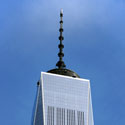Filter by
You must be a CTBUH Member to view this resource.
Chicago Spire
Building
Never Completed
60611
residential
steel/concrete
609.6 m / 2,000 ft
150
7
1194
85,470 m² / 919,991 ft²
Usually involved in the front end design, with a "typical" condition being that of a leadership role through either Schematic Design or Design Development, and then a monitoring role through the CD and CA phases.
Usually takes on the balance of the architectural effort not executed by the "Design Architect," typically responsible for the construction documents, conforming to local codes, etc. May often be referred to as "Executive," "Associate," or "Local" Architect, however, for consistency CTBUH uses the term "Architect of Record" exclusively.
The Design Engineer is usually involved in the front end design, typically taking the leadership role in the Schematic Design and Design Development, and then a monitoring role through the CD and CA phases.
The Design Engineer is usually involved in the front end design, typically taking the leadership role in the Schematic Design and Design Development, and then a monitoring role through the CD and CA phases.
Other Consultant refers to other organizations which provided significant consultation services for a building project (e.g. wind consultants, environmental consultants, fire and life safety consultants, etc).
You must be a CTBUH Member to view this resource.
Usually involved in the front end design, with a "typical" condition being that of a leadership role through either Schematic Design or Design Development, and then a monitoring role through the CD and CA phases.
Usually takes on the balance of the architectural effort not executed by the "Design Architect," typically responsible for the construction documents, conforming to local codes, etc. May often be referred to as "Executive," "Associate," or "Local" Architect, however, for consistency CTBUH uses the term "Architect of Record" exclusively.
The Design Engineer is usually involved in the front end design, typically taking the leadership role in the Schematic Design and Design Development, and then a monitoring role through the CD and CA phases.
The Peer Review Engineer traditionally comments on the information produced by another party, and to render second opinions, but not to initiate what the design looks like from the start.
The Design Engineer is usually involved in the front end design, typically taking the leadership role in the Schematic Design and Design Development, and then a monitoring role through the CD and CA phases.
Other Consultant refers to other organizations which provided significant consultation services for a building project (e.g. wind consultants, environmental consultants, fire and life safety consultants, etc).
These are firms that consult on the design of a building's façade. May often be referred to as "Cladding," "Envelope," "Exterior Wall," or "Curtain Wall" Consultant, however, for consistency CTBUH uses the term "Façade Consultant" exclusively.
Mine the Gap Competition
15 May 2010 - Event

21 October 2018 | Chicago
A Monument to the World: Dubai Creek Tower
The Dubai Creek Tower’s monumental design is influenced by the natural forms of the lily and evokes the shape of a minaret, a distinctive architectural...

27 January 2012
Debating Tall: A Supertall Future in the US?
Adrian Smith, Adrian Smith + Gordon Gill Architecture; Paul Beitler, Beitler Real Estate Services LLC
In 1990, only 11 buildings in the world could be counted as a “supertall” (defined as a building over 300 meters tall), and all but...

21 October 2018 | Chicago
A Monument to the World: Dubai Creek Tower
The Dubai Creek Tower’s monumental design is influenced by the natural forms of the lily and evokes the shape of a minaret, a distinctive architectural...

15 January 2016 | Chicago
Thursday 12th November 2015. Chicago, IL. Santiago Calatrava discusses the 2015 CTBUH 10 Year Award Winner, Turning Torso during the 2015 CTBUH Awards Symposium at...

12 November 2015 | Chicago
Santiago Calatrava, Founder, Santiago Calatrava Architects & Engineers, is interviewed by Chris Bentley regarding the 2015 CTBUH Tall Building 10 Year Award Winner, Turning Torso,...

26 October 2015 | Chicago
Adrian Smith of Adrian Smith + Gordon Gill Architecture is interviewed by Chris Bentley during the 2015 CTBUH New York Conference at the Grand Hyatt...

07 November 2013 | Chicago
Fazlur Khan Lifetime Achievement Medal: Geotechnics for the World’s Tallest
Clyde Baker has performed geotechnical engineering for seven of the 16 tallest buildings in the world, and a major portion of the high-rise buildings built...

07 November 2013 | Chicago
Interview: Fazlur Khan Winner: Clyde Baker
Clyde N. Baker, Jr., Fazlur R. Khan Lifetime Achievement Medal Winner, discusses his lifetime work as a geotechnical engineer including working on 7 of the...

18 October 2012 | Chicago
Fazlur Kahn Lifetime Achievement Medal: A Lifetime’s Engineering Collaboration
The partnership between Charles Thornton and Richard Tomasetti has provided the backbone for many of the most dramatic and innovative tall buildings around the world....

05 February 2010 | Chicago
Tall and Supertall Buildings: Structure and Skin Performance
There are many challenges and opportunities in designing the structure and skin of high performing tall buildings. Examples from different regions highlight responses to wind...

22 October 2009 | Chicago
Chicago Spire: Technical Twisting and Turning
For the best part of a decade, Asia eclipsed the U.S. as the leader in the world’s tallest buildings. In the mid-2000s, however, a number...

22 October 2009 | Chicago
Richard Tomasetti of Thornton Tomasetti is interviewed by Jeff Herzer during the 2009 CTBUH Chicago Conference at Illinois Institute of Technology, Chicago. Richard talks about...
Subscribe below to receive periodic updates from CTBUH on the latest Tall Building and Urban news and CTBUH initiatives, including our monthly newsletter. Fields with a red asterisk (*) next to them are required.
View our privacy policy